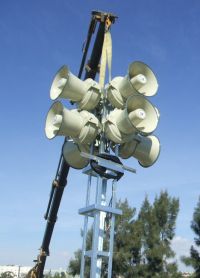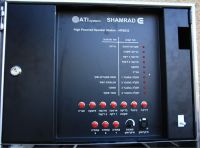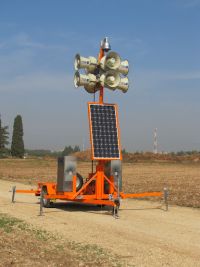Shamrad Electronics
Shamrad Electronics, Ltd.[1], also known as Shamrad Electronic(s) Industries, Ltd. or simply Shamrad, is a Petah Tikva, Central District-based supplier of security and IT systems, founded in 1977. Shamrad is an Israeli dealer of ATI Systems' outdoor warning sirens, and offers the HPSS32 and MHPSS32 models. Shamrad is 1 of 2 dominant siren dealers in the country, the other being Elpam Electronics, who rebrands HÖRMANN's ECN.
Products
HPSS32


The HPSS32 is Shamrad's main offering, and is a rebranded and modified version of the standard HPSS32 produced by ATI Systems. The HPSS16, the 1600 W variant, is apparently produced by Shamrad as well, but absolutely none of these are known to exist. Like the original siren, the HPSS32 consists of 8 DK TEC TU-300 speakers, with 2 facing each direction. Whether or not Shamrad gets their arrays from ATI or DK TEC themselves is unclear, as Shamrad HPSS32s have been found with DK TEC speakers on the throats of their horns. These speakers are attached to a rectangular frame, which is comparatively taller in length than HPSS32s produced by ATI themselves. Shamrad's HPSS32 is only intended to be mounted to the roof of a building; as such, a base allowing the siren to be bolted down is located at the bottom of the frame. In terms of controls, ATI and Shamrad's units are essentially one in the same, with probably the only difference being the alternate tone sets and the labels of buttons and indicators on the controllers of Shamrad units being translated into Hebrew from English. The HPSS32 is driven by 2 1600 W amps (patented by ATI themselves), which gives more leeway if one of the amps fails, as the siren will simply function with half the wattage rather than failing entirely. These amps unfortunately lack sufficient heatsinks, commonly leading to overheating issues as observed with American units; this problem would likely be even more frequent of an occurrence with Israeli units given the hot temperatures that these sirens have to endure. The amps also use sine waves instead of square waves, which causes the siren to sound muddy. Sine waves have the benefit of providing excellent voice intelligibility, however, which is one of the HPSS's main selling points. Unlike other electronic sirens, the HPSS32 prepares the amps and drivers before activating, which results in a very high-pitched screech from the siren just before it activates. This is apparently to prolong the life of the drivers, though this claim is dubious at best. Due to the cheap manufacturing of these sirens they are infamous for their unreliability. ATI rates their HPSS32 at 127 dB at 100 ft, rivaling the ASC E-Class EC-8 and Whelen WPS-2908. However, an independent study by Georgia Tech has found they perform closer to 115 dB at 100 ft.
MHPSS32

Shamrad also produces a 3200 W version of ATI's Mobile HPSS (MHPSS), named the MHPSS32. No 1600 W variant of the MPHSS32 is known to be offered by Shamrad. Shamrad's version of the MHPSS differs slightly than ATIs but share similar characteristics; Shamrad's MHPSS32 is a mobile speaker station consisting of a standard speaker array placed on a foldable telescoping arm, a solar panel, the siren controller (as well as a separate enclosure with an unknown purpose located opposite to the siren controller, which is not present on ATI units), batteries, a 360° camera and an independently deployable two-wheeled trailer. An extra spare tire is also included. When the siren needs to be deployed, 4 legs are extended onto the ground for support, and the main arm unfolds and extends to its full height with the array. The MHPSS32 is designed for use in areas without reliable mains power, such as in areas affected by disaster, or for public events or military installations where a permanent speaker array is unnecessary. When it is no longer needed, the arm folds neatly onto the trailer and the legs can be pulled back up so the trailer may be towed.